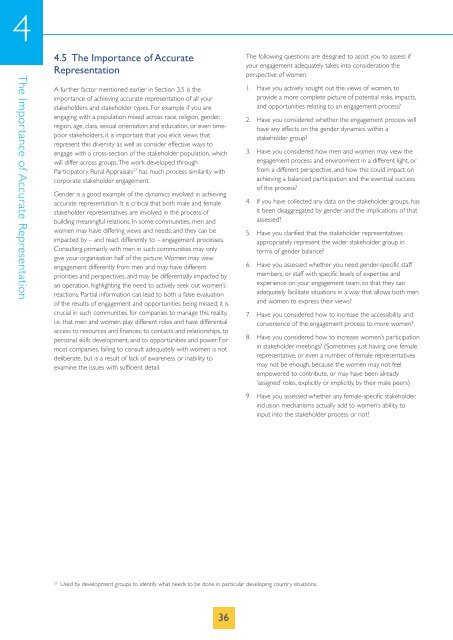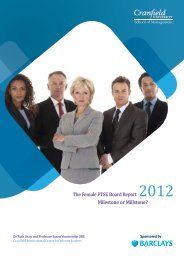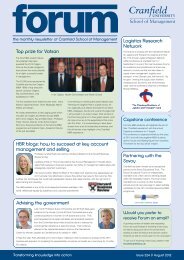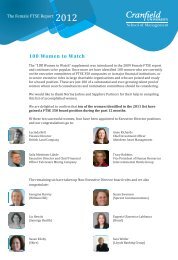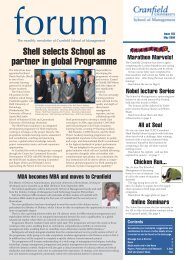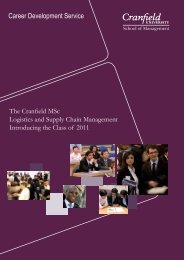Stakeholder Engagement - Cranfield School of Management ...
Stakeholder Engagement - Cranfield School of Management ...
Stakeholder Engagement - Cranfield School of Management ...
Create successful ePaper yourself
Turn your PDF publications into a flip-book with our unique Google optimized e-Paper software.
4<br />
The Importance <strong>of</strong> Accurate Representation<br />
4.5 The Importance <strong>of</strong> Accurate<br />
Representation<br />
A further factor mentioned earlier in Section 3.5 is the<br />
importance <strong>of</strong> achieving accurate representation <strong>of</strong> all your<br />
stakeholders and stakeholder types. For example if you are<br />
engaging with a population mixed across race, religion, gender,<br />
region, age, class, sexual orientation and education, or even timepoor<br />
stakeholders, it is important that you elicit views that<br />
represent this diversity as well as consider effective ways to<br />
engage with a cross-section <strong>of</strong> the stakeholder population, which<br />
will differ across groups.The work developed through<br />
Participatory Rural Appraisals 27 has much process similarity with<br />
corporate stakeholder engagement.<br />
Gender is a good example <strong>of</strong> the dynamics involved in achieving<br />
accurate representation. It is critical that both male and female<br />
stakeholder representatives are involved in the process <strong>of</strong><br />
building meaningful relations. In some communities, men and<br />
women may have differing views and needs; and they can be<br />
impacted by – and react differently to – engagement processes.<br />
Consulting primarily with men in such communities may only<br />
give your organisation half <strong>of</strong> the picture.Women may view<br />
engagement differently from men and may have different<br />
priorities and perspectives, and may be differentially impacted by<br />
an operation, highlighting the need to actively seek out women’s<br />
reactions. Partial information can lead to both a false evaluation<br />
<strong>of</strong> the results <strong>of</strong> engagement and opportunities being missed; it is<br />
crucial in such communities for companies to manage this reality,<br />
i.e. that men and women play different roles and have differential<br />
access to resources and finances, to contacts and relationships, to<br />
personal skills development, and to opportunities and power. For<br />
most companies, failing to consult adequately with women is not<br />
deliberate, but is a result <strong>of</strong> lack <strong>of</strong> awareness or inability to<br />
examine the issues with sufficient detail.<br />
27 Used by development groups to identify what needs to be done in particular developing country situations.<br />
36<br />
The following questions are designed to assist you to assess if<br />
your engagement adequately takes into consideration the<br />
perspective <strong>of</strong> women.<br />
1. Have you actively sought out the views <strong>of</strong> women, to<br />
provide a more complete picture <strong>of</strong> potential risks, impacts,<br />
and opportunities relating to an engagement process?<br />
2. Have you considered whether the engagement process will<br />
have any effects on the gender dynamics within a<br />
stakeholder group?<br />
3. Have you considered how men and women may view the<br />
engagement process and environment in a different light, or<br />
from a different perspective, and how this could impact on<br />
achieving a balanced participation and the eventual success<br />
<strong>of</strong> the process?<br />
4. If you have collected any data on the stakeholder groups, has<br />
it been disaggregated by gender and the implications <strong>of</strong> that<br />
assessed?<br />
5. Have you clarified that the stakeholder representatives<br />
appropriately represent the wider stakeholder group in<br />
terms <strong>of</strong> gender balance?<br />
6. Have you assessed whether you need gender-specific staff<br />
members, or staff with specific levels <strong>of</strong> expertise and<br />
experience on your engagement team, so that they can<br />
adequately facilitate situations in a way that allows both men<br />
and women to express their views?<br />
7. Have you considered how to increase the accessibility and<br />
convenience <strong>of</strong> the engagement process to more women?<br />
8. Have you considered how to increase women’s participation<br />
in stakeholder meetings? (Sometimes just having one female<br />
representative, or even a number <strong>of</strong> female representatives<br />
may not be enough, because the women may not feel<br />
empowered to contribute, or may have been already<br />
‘assigned’ roles, explicitly or implicitly, by their male peers)<br />
9. Have you assessed whether any female-specific stakeholder<br />
inclusion mechanisms actually add to women’s ability to<br />
input into the stakeholder process or not?


